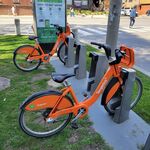Okay, you're smart enough to know that's anecdotal.
I'm not as dumb as I look.....I'm dumber.

Of course I know it's anecdotal. I was using it as a glaring example of the broken testing system we do have, and I think it's a good example as you'll see upon reading my elaboration below.
Was your friend trying to walk in and get a test after they required appointment? Was he trying to get a test in a pharmacy (who aren't testing those with symptoms)? Was he trying to get the test early on, when they were being extremely strict in regards to symptoms?
So, at first he tried getting tested at a pharmacy. They sent him to another pharmacy to get tested....they told him they were testing symptomatic people at this other pharmacy. That was obviously wrong.
So I told him to phone telehealth where they told him he didn't qualify for testing.
By the way, he wasn't too concerned himself.....I had to bother him for over a week to go get tested and then he finally lied his way into getting an appointment at our local hospital after his symptoms worsened. He's a bit of a dick when it comes to taking care of himself. hahaha
And no, this was over the holidays, so not early on.
The province isn't publishing that data to my knowledge. But it's certainly not enough to be judged newsworthy.
How can you qualify it if it hasn't ever been published?
Do you work in the medical field? I'm kind of getting that impression from you.
But note this:
The reason we shifted asymptomatic/non-contact testing to pharmacies is because the vast majority were turning up negative. The numbers weren't high enough to warrant immediate results or justify the load on the symptomatic system.
Again, as above, you either know something the rest of us don't or you're just making things up by guessing at what those numbers are/were.
Are these data available anywhere?
The "general population" asymptotic testing done at schools in Ontario has turned up surprisingly low numbers. Much lower than expected, especially considering kids are more often asymptomatic than adults, and less than the general testing positivity rate — <1% outside of a known outbreak:
The province plans to expand asymptomatic testing program in 2021 as opposition critics call for action.

www.thestar.com
Ah, nice. So we're fine then. Seems it isn't as virulent as previously thought.

Nah, I'm playing. Is it possible though that children, who are known to have generally benign outcomes with this infection, are testing negative in large numbers because of inherent immune response leading to early virion elimination upon infection?
I'm assuming their immune response is the reason they have had generally benign outcomes...I don't know the actual mechanism by which this is the case.
The Lavezzo et al study ("Suppression of a SARS-CoV-2 outbreak in the Italian municipality of Vo’";
https://www.nature.com/articles/s41586-020-2488-1), is unintentionally problematic due to how early in the pandemic it was. Very little was known about Covid-19 then, and incubation periods hadn't yet been sussed out. The sampling was done over two periods, with a mean of 6.9 days offset. We now know that it can take up to 14 days for symptoms to appear.
Fair point. It'd be interesting to see if there have been any such follow up studies done in Europe during the second wave.
The Czechs might be cooking something up as they have had at points the highest per capita infection rates in the second wave and are also testing robustly...including widespread antigen testing.
Regardless of that, between symptomatic and asymptomatic positives the total was 91 people. 32 of those were asymptomatic. Not exactly a robust sampling number of asymptomatic infections.
Yeah, that is weak, but then so was the entire meta-analysis from what I could tell.
You're cherry picking one portion of data and implying its representative of the whole.
There wasn't much to go by in that meta-analysis. The other studies presented were also problematice for other reasons. You're right though, I went with what was there which wasn't much of anything.
As a science teacher once pointed out, "data is lumpy" and this type of data is highly stochastic.
I told you I was dumber even than I look and you go and throw down words like this. Never even heard of this stochastic. Is this some stats term?
Don't worry, I looked it up so I know what it means, but geeeeeeeze.

Regional, genetic or social traits could account for a higher asymptomatic number, as could the smaller followup window on a number of the cases. It's the aggregate that matters. More data provides more clarity and accuracy.
Facts.
This is why more data will always trump fewer, and why you can't just use confirmation bias to pull a 40% out of an aggregate 17% as proof of anything. Nor can I use the 4% asymptomatic rate in the Korean study (Park et al, "Coronavirus Disease Outbreak in Call Center, South Korea. Emerging infectious diseases")
I used that one because it was the only study cited done on a general population.
As I said, that whole meta-analysis is kinda bunk.
Spontaneous generation theory was disproven centuries ago, so general population testing is great, but *known* contact should guarantee a more accurate asymptomatic percentage. Implying random GenPop is more accurate is disingenuous.
I don't see why general population testing should have anything to do with spontaneous generation, but it makes sense that known contact with infected individuals should be more accurate than general population testing but in that meta-analysis, it looks like they used studies that may have had a bias toward higher viral load-bearing cases which would likely lead to higher incidence of both transmission and likelihood of increased symptoms in contacts.
The assumption that asymptomatic are super spreaders is also countered by the studies showing that asymptomatic positives are actually 40% less likely to shed enough virus to infect others. Even the original article I posted said this:
"Byambasuren’s review also found that asymptomatic individuals were 42% less likely to transmit the virus than symptomatic people."
Yeah, I've never doubted that asymptomatic carriers were less likely to transmit the virus. That seems intuitive.
It's *only* 2-3% because of intervention, both medical and social. This is how many are dying with all the things we're trying to do to stop it. Unchecked, that number would be higher.
Yes but the fact remains that it is 2-3%. The reason why it's so low doesn't matter. I think you're overstating how much social intervention has on the fatality rate.
It's quite probably as low as it is almost entirely due to medical intervention and the nature of the illness.
We know this virus disproportionately affects certain demographics, chiefly already ill people.
Don't try to justify your anti-lockdown stance by trying to diminish deaths. It looks awfully selfish.
I'm not diminishing deaths. I'm just considering the deaths of certain people for what they are: inevitable.
I'm also not "anti-lockdown"; I'm anti-reactionary nonsense.
You know what's selfish? Sabotaging the chance at a decent life for a generation of wee people who can't speak for themselves.
I don't see what's selfish about advocating for the wellbeing of children.
I'll say it again: I value the potential and future lives of children over that of decrepit oldsters or people living stunted lives due to chronic disease. I won't apologise for that and there's nothing selfish about it. I don't even have children, but I do have people with chronic disease in my life (ie see above).
A balance between the interests of these two disparate groups has not been found and that is to our collective detriment.
The 1918 Spanish Flu killed 2.5% of cases. And that was with far less intervention than what's been done with Covid. We didn't have ventilators (1928), anti-viral medications (1960s), corticosteroids (1950), blood thinners (1941), monoclonal antibody therapy (1975) or a vaccine (first influenza vaccine, 1930s).
Yeah, but it was a different virus. What's the fatality rate of ebola?
So why are you so certain that our numbers are "multiples" higher than our confirmed positives then?
Clearly I'm going on old information from early in the pandemic and stand corrected. I'm still not convinced by that rather faulty meta-analysis but it's sure looking like the numbers are faaaaar lower than at first thought.
Can I go out and play now?






/https://www.thestar.com/content/dam/thestar/politics/provincial/2020/12/17/school-testing-finds-57-covid-cases-so-far-in-more-than-4500-tests-to-date-in-toronto-peel-york-ottawa/thorncliffe.jpg)
